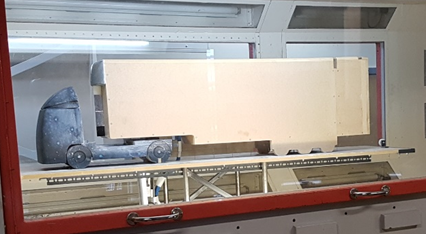The proof is in the driving: 6 ways to test aerodynamic performance

At Aerodyne we pride ourselves in being knowledgeable in truck aerodynamics. Our team has around 43 years of experience, we run a robust production operation and are ready for growth in the pursuit of becoming the number one global trusted advisor in truck aerodynamics.
But this is nothing without evidence.
When we look at the figures and measurements involved in measuring carbon footprints, we see that even the smallest percentages are material. Trucking is thought to generate less than 4.5% of the carbon footprint attributed to the entire transport sector. However, this really is a case of ‘every little counts’ and, at Aerodyne, we believe fleet operators need to do everything they can, as soon as they can, to mitigate damage to the environment.
And that is why we test our products. The results give credibility to our claims. They justify the investment of our clients and demonstrate the return they can expect and the timescale in which they can expect it. There are six recognised methods of testing the performance of aerodynamics and we thought it would be useful to explain them to you.
1. Full-size wind tunnel
As you might expect, this approach provides excellent and highly accurate data because it allows the use of actual trucks and actual kit. However, there’s only one wind tunnel in Europe that is large enough to carry out these tests. It comes with high costs and a very long waiting list. In addition, it only allows for limited testing of yaw angles as the trucks are too large to sit at 5-7-degree angles within it.
That said, it’s a pretty impressive set-up as shown in this video made by Scania.
2. Scale wind tunnel
These smaller wind tunnels are a good alternative, as they are relatively easy to set up and can test different scenarios. They’re easily available, such as the one located at Cranfield University and much more cost effective. However, there is a catch. The model trucks that need to be used tend to lack details which has an impact on the accuracy of the results. Perhaps not surprising when the smallest angle or curved edge can considerably change the aerodynamic performance of such a large vehicle.
3. Computational Fluid Dynamics (CFD)
CFD testing is relatively cost-effective method which uses computers to test the flow of any liquid or gas, including air. Its accuracy depends on the input models so there is room for error, but it is used in a wide range of industries and particularly for the analysis of aerodynamics.
4. Track Testing
Of course, nothing beats a real-life scenario, and it is possible to test the actual truck and trailer on a variety of surfaces at a proving ground. This type of testing affords the opportunity to interchange and compare aerodynamic devices. However, it’s important to remember that trucks don’t drive in repetitive conditions so the results may not fully represent an actual journey.
5. In fleet testing
This type of testing uses real life conditions, routes and driver behaviours. It’s cost effective as it takes place during normal operational periods and uses the vehicle’s telematic system to glean results. However, on the downside, it can be difficult to get accurate comparisons because of the sheer number of potential variables, from the weather to traffic and vehicle weights.
6. Coast Down Testing
The final type of testing involves driving the truck on a straight & level road with no wind. The starting speed for testing is 15mph, at which point the driver puts the vehicle into neutral gear and coasts to a standstill. The time taken to decelerate from 15mph to 0 is measured.
Doing this allows us to calculate the overall rolling resistance, including rotary inertia of moving parts such as wheels, engine, and transmission. The test is then repeated at a higher speed, such as 45mph, and the time to coast to a standstill is again measured. The key calculation is then to subtract the rolling resistance (the first measurement taken) and calculate the Drag Coefficient.
At this point, aerodynamic devices can be added and the 45mph test repeated. Again, the Drag Coefficient is calculated and any improvement seen in the reduction achieved by the second test. This test needs to take place in a wind-free environment and is usually done either on the plains of Kansas, on disused aerodrome runways, or in the Catesby Tunnel near Northampton.
As we said at the start of this blog, when margins are slight and even the smallest percentages are material, it’s critical to undertake testing to understand that our kit is making a difference. When we work with a business to help them improve fleet performance we have this data to hand and can provide highly accurate and detailed summaries of the fuel efficiency and drag coefficient they can expect to achieve. We know how important ROI is to you and we are more than happy to help you prove the value of using our kit on your fleet.
If you’d like to assess how we can help you, please get in touch with us on 01778 422 000 or email sales@aerodyneuk.com and become the change you want to see for the world.
